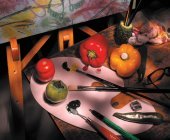|
Complementary colorsComplementary colors are opposite colors on a color wheel. When any of two such colors are mixed, theoretically, they will produce a black color. In theory, when solid cyan, magenta and yellow colors are printed, it produces a black color. C + M + Y = black Red (mixture of magenta and yellow) is the complementary of cyan. Now if we add red + cyan, it will be (M + Y) + C = black This list further goes as following: Blue is complementary to yellow Green is complementary to magenta Black is complementary to white
These colors are primary colors, and they create a massive color contrast. Use of these combination with addition of other elements create a visual complexity, and we loose charm of a photograph.
These colors work well with frontal soft lighting. They are used when shape is the key element of a photograph. However, if these colors are made lighter or dull, then they no more remain as a true complementary of each other, as the mixture cannot produce black.This combination is very useful in black and white photography. Any color in the subject can be altered with a colored filter on the lens. If there is blue sky in the subject, and we want to record it as white, then a blue filter in front of the lens will be needed. However, if we put a yellow colored filter, which is complementary color of blue, then blue sky will be recorded as black. So in such a case, sky is recorded as dark grey (because blue in the sky is not pure blue) and the clouds will stand out against darker sky. If the filter is not used, then clouds will be mixed with white sky. In color photography, when a red object is shot against cyan background, which is complementary color of red, maximum color contrast is achieved. In such case, if the lens is not corrected for chromatic aberration, a black line is produced at the border of red and cyan. This type of contamination spoils the visual appeal of a photograph, so we have to be careful when shooting with such lens. Read about lens faults. Read more about how other colors work in a photograph:
Return back to Colors from Complementary colors
|






